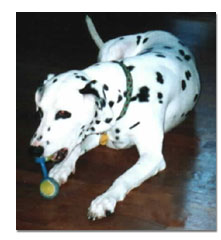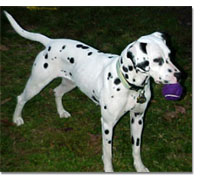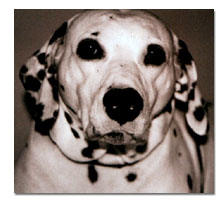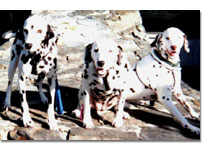Breed Profile
--Written by Alison O Sullivan

 Breed: Breed:
Dalmatian. Made famous by the 1959 animated film 101 dalmatians
Owner Level:
Suitable for some active and involved first time owners.
Average Life Span:
12 years
Average Weight:
50-65 lbs
Height:
18-28 inches
Color And Coat:
White with black spots or white with brown (liver) spots. Newborn puppies typically show no spots until their second week. The coat is short and dense and shedding is excessive year round. Brushing two to three times a week is usually sufficient to minimize shedding.
 Typical Health Problems: Typical Health Problems:
About 12% of the breed are born deaf. No bloodlines are free from the problem. Dalmatians also have the potential to form urate stones due to not being able to correctly metabolize purine-yielding foods such as liver and beef. This is easily controlled through diet and is rarely life threatening. Some dalmatians may have skin or coat problems such as fleabite dermatitis, or allergic reactions to grasses, dust or pollen. Keeping the yard flea free and feeding a high quality food can avoid a lot of skin problems. Dalmatians do poorly as outside only dogs. Their sensitive skin and short hair does not allow them to handle weather extremes well and they will pick up fungi from moist soil and grass. Don't forget the sunscreen on those little pink noses in the summertime they can burn just like yours.
 History and Personality: History and Personality:
Historians believe that dalmatians originated in India as a lightly spotted hound type dog treasured by gypsies because of their flashy markings and eagerness to have fun. Dalmatians traveled throughout Europe and Asia with the gypsies eventually arriving in Europe around the late 1780's when members of the British upper class brought them home from their frequent trips to continental Europe. The aristocracy hoped to use them as hunting dogs but soon discovered that they were better companions to horse drawn carriages because they liked running along side the horses, which explains why they were called carriage dogs.
It is unknown when the breed was introduced to this country. The first dalmatian registered by the AKC was in 1888. In 1905 the Dalmatian Club of America was founded. Their favorite pastime was testing dog's speed and endurance while trotting along side a carriage and/or horses (road trials - a hobby that is still pursued today). The dals association with carriages and horses also opened up a new career opportunity for the breed. Dalmatians received the nickname "fire dog" as they were the dogs that lived in the stables with the horses that pulled the water pumpers used to put out fires. When the alarm bell sounded the dogs ran behind the horses or led the way through the streets. After motor cars replaced the horses and carriages the dogs moved into the fire stations and enjoyed riding atop the engines. Over the last 40 years most fire stations have not been able to keep dalmatians as many urban fire stations lack the necessary space and personnel are often shifted between stations and given irregular shift assignments.
 Bred to run for hours under or along side a coach most dalmatians do not tire easily. This means the dalmatian is an active and energetic dog that enjoys lots of exercise. Dalmatians are people-like and people oriented. If you are looking to adopt a dal be prepared to make them part of your life. Dalmatians are happiest accompanying their owners wherever they go. Dalmatians are typically aloof with strangers, however once they get to know them the person may get treated to the famous dalmatian smile or smarl, which can be disarming to someone unfamiliar with dalmatians. Dalmatians can be very vocal they coo, grunt, and sometimes give you a whistling yawn when trying to be particularly coy (usually seen when they are trying to avoid punishment). Bred to run for hours under or along side a coach most dalmatians do not tire easily. This means the dalmatian is an active and energetic dog that enjoys lots of exercise. Dalmatians are people-like and people oriented. If you are looking to adopt a dal be prepared to make them part of your life. Dalmatians are happiest accompanying their owners wherever they go. Dalmatians are typically aloof with strangers, however once they get to know them the person may get treated to the famous dalmatian smile or smarl, which can be disarming to someone unfamiliar with dalmatians. Dalmatians can be very vocal they coo, grunt, and sometimes give you a whistling yawn when trying to be particularly coy (usually seen when they are trying to avoid punishment).
Why are these dogs typically in animal shelters?
Dalmatians typically end up in shelters for several reasons.
 Overbreeding. As a result of the Disney movies many parents rushed out to buy their children a dalmatian thinking they would be just like the cute, bouncy puppies they saw in the movies. These people didn't stop to think that the cute little puppy they brought home would quickly grow into a 50-pound energetic dog. Overbreeding. As a result of the Disney movies many parents rushed out to buy their children a dalmatian thinking they would be just like the cute, bouncy puppies they saw in the movies. These people didn't stop to think that the cute little puppy they brought home would quickly grow into a 50-pound energetic dog.
- Problem behaviors. Dalmatians are often headstrong and stubborn and if you do not provide consistent training and boundaries you will end up with an unmanageable adult. Dalmatians can become easily bored and have an independent streak. Owners not willing to spend enough time with their dal will end up with a dog that is rambunctious and destructive typically developing problem behavior such as fence climbing, chewing, digging, or barking.
- This breed, although smart, can be stubborn to train. Conventional training does not work with dalmatians. They respond best to positive training methods as opposed to methods which rely on scolding and telling the dog "no" all the time. These dogs are often dumped in shelters by owner unwilling to take the time to properly train them.
 How do these dogs handle rescue or shelter life? How do these dogs handle rescue or shelter life?
No dog thrives in a shelter situation. As with any other breed, dalmatians in shelters can become frantic and start barking and jumping on the kennel or they become depressed.
Who should own this breed?
The ideal dalmatian owner should be patient and committed to giving them the attention and training they require. Many dalmatian owners have found themselves overwhelmed and unprepared for the time and attention this breed requires. People that work long hours or are away from their home for extended periods of time should not own a dalmatian.
Is this breed good with children?
Dalmatians make good family pets in the right situation. Parents with small children (under 6 years) should be aware that dals can be very exuberant and can accidentally knock down a child. Small children must be taught not to poke eyes or pull tails; both dals and children need to learn proper behavior. However, please understand that no dog should ever be left unsupervised with children; children don't always know how to treat a dog and every dog does have its limit.
 How easy is training and house training with this breed? How easy is training and house training with this breed?
Dalmatians have a reputation for being stupid and difficult to train. This is absolutely incorrect, as they are actually extremely intelligent and creative. They are smart enough to recognize a situation where the owner is unable or unwilling to enforce a command.
Is this breed good with other dogs in general?
Dalmatians usually get along well with other dogs and do well in multi-pet households. Dals can get along great with cats if introduced properly

|

